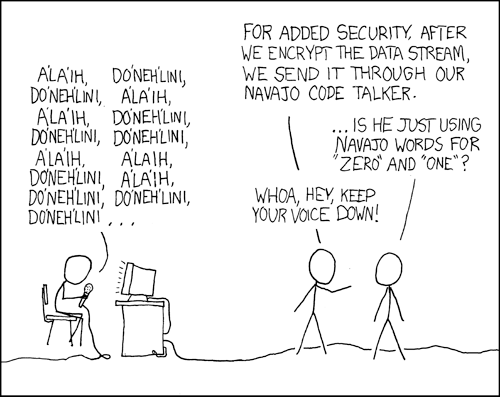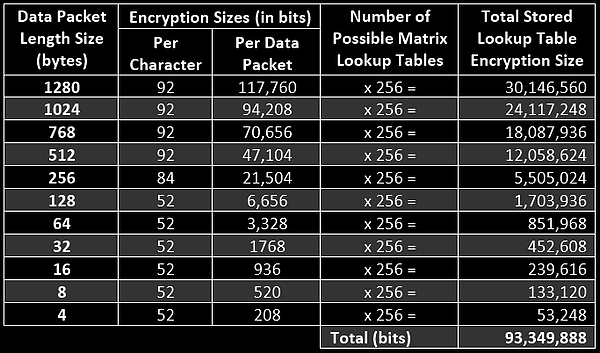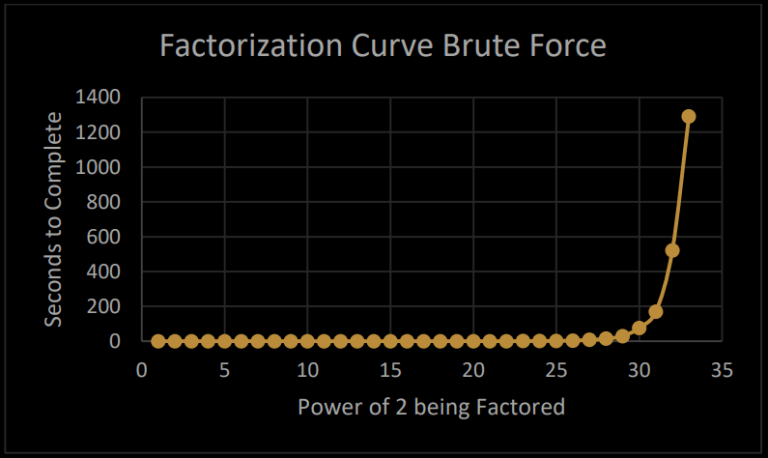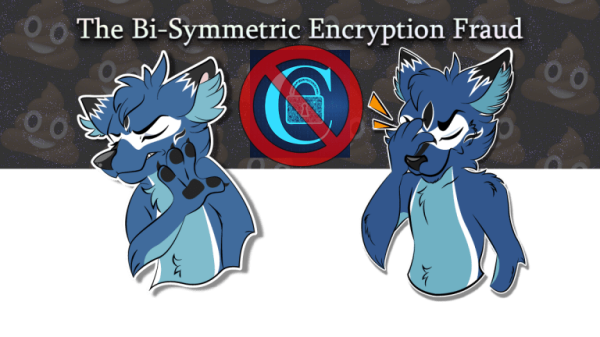Search
Items tagged with: crackpots
Earlier this year I discussed some noteworthy examples of crackpot cryptography and snake-oil security on this blog.
In this post, I’m going to analyze the claims made by CEW Systems Canada about “Post-Quantum Encryption” and argue that their so-called “bi-symmetric encryption” is another example of the same genre of crackpot cryptography.
https://twitter.com/veorq/status/1159575230970396672
Let’s get the disclaimers out of the way: This post was written solely by some security engineer with a fursona that has happens to have a lot of opinions about cryptography. This post is solely the opinion of said author, who also claims to be a blue anthropomorphic dhole, and not the opinion of any employer (especially his).

It’s entirely up to you whether or not you want to take me seriously, knowing all of that.
Additionally, by “fraud” I am not speaking in a legal sense, but a colloquial sense.
What Is “Bi-Symmetric Encryption”?
CEW Systems, a Canadian company incorporated in December 2020 by Chad Edward Wanless, claims to have developed a technique called “bi-symmetric encryption”, which they describe as follows:
What exactly is Bi-Symmetric encryption?Bi-symmetric encryption is an internet communications handshake protocol that uses public/private keys similar to typical asymmetric encryption, but instead uses an underlying symmetric encryption system as the encryption backbone.
(source)
Their FAQ page goes on to claim:
Why is it called Bi-Symmetric?We chose bi-symmetric encryption as the name because the encryption handshake is a hybrid of both asymmetric and symmetric encryption. It uses public/private keys just as asymmetric encryption does, while using symmetric encryption called CEW encryption as the underlying encryption software routine.
(source)
Ah, what a contradiction! According to this page, bi-symmetric encryption is a handshake protocol that simultaneously:
- Uses public/private keys just as asymmetric encryption does, but
- Uses an underlying symmetric encryption system
But if your underlying encryption for the handshake is entirely symmetric, where do the asymmetric keypairs come in?
Asymmetric cryptography has public/private keypairs because their security is based on a hard computational problem (large integer factorization, the elliptic curve discrete logarithm problem, etc.). You can generally take a private key (or some secret seed that generates both keys) and easily derive its public key, but doing the opposite is prohibitively expensive.
If you’re only using symmetric cryptography, you don’t have this hard computational problem in the mix, so where do the keypairs come in?
The FAQ goes on to imply that bi-symmetric encryption is resistant to brute-force attack, and then vaguely describes One-Time Passwords (a.k.a. two-factor authentication codes).
Brute force attacks on an ordinary computer work by incrementally testing possible values until the desired output response is found. For example, if a vehicle was locked and a smart device is used to hack it, the brute force attack would start at 0,000,000 and say, the unlock code was 1,234,678, the device would resend the code incrementally advancing the value by 1. The signals would repeat until the correct value was eventually found and the vehicle unlocked. Bi-symmetric software works by using a challenge code and test data combination that changes the unlock code for each attempt. Staring at 0,000,000 and incrementing to 9,999,999 would not unlock the vehicle as the unlock could would always be changing with every attempt.(source)
Even if you’re not a cryptography expert, I hope it’s clear that “synchronized random numbers” (one-time passwords) and “mangling a message so no one else can understand its contents without the key” (symmetric encryption) are totally disparate operations, and not at all interchangeable.
But here’s where things get really funny. After all this confusing and contradictory bullshit, they say this:
Another reason is that asymmetric encryption relies upon a math formula to determine what the private key is by factoring the public key. Bi-symmetric encryption does not mathematically correlate the two, instead one is encrypted by the other.(source)
Yeah, that concept already exists. It’s called envelope encryption, my dudes. There’s nothing magically post-quantum about envelope encryption, and it doesn’t obviate the need for asymmetric cryptography.
And if both keys are symmetric, and you’re communicating them in the clear, then what’s to stop someone from using the algorithm the same way a legitimate user does?
Of course, now that we’ve gotten to the meaty center, the remainder of the FAQ entry is the other half of the bullshit sandwich.
The largest reason asymmetric encryption is vulnerable is that the entire plain text being encrypted is mathematically modified using a math formula.(source)
What are they even talking about?

There are a lot of problems with asymmetric encryption. For example: Developers encrypting directly with RSA. This is an antipattern that I’ve complained about before.
But asymmetric encryption isn’t, as a whole, “vulnerable” to anything.
The reason NIST and other standards organizations are focused on post-quantum cryptography is that the currently-deployed asymmetric cryptographic algorithms (RSA, ECC) are broken by a quantum computer (if it ever exists). The solution is to study and standardize better asymmetric algorithms, not throw out the entire class of algorithms, forever.
The fact that quantum computers break RSA and ECC has nothing to do with “the entire plain text being encrypted”, as CEW Systems claims, because that’s generally not what’s actually happening.
If you use TLS 1.2 or 1.3 to connect to a website, one of the following things is happening:
- You have an existing session, no handshake needed.
- Your browser and the webserver use Elliptic Curve Diffie-Hellman to establish a session key. The server’s ephemeral public key is signed by the ECDSA or RSA key in their Certificate, which has been signed by a Certificate Authority independently trusted by the browser and/or operating system you use.
- Your browser encrypts a random value, called the pre-master secret, using the RSA Public Key on the Certificate. The pre-master secret is used by the server to derive the session key for subsequent connections. This doesn’t have forward secrecy like option 2 does, but it’s otherwise secure.
At no point is “the plain text” ever encrypted directly. The ECC option doesn’t even do asymmetric encryption the same way RSA does. ECC is used for key agreement, exclusively.
Understanding the basics of “how cryptography is used” is table stakes for even thinking about inventing your own cryptography, and CEW Systems cannot even clear that bar.
With the under lying encryption of bi-symmetric, each individual letter is modified separately, there is no mathematical link to the entire plain text being encrypted.(source)
https://www.youtube.com/watch?v=QC1WeLyOjj0
The charitable interpretation is that they’re describing a stream cipher, or a block cipher used in Counter Mode.
A more likely interpretation is that they’re encrypting each letter independently in something like ECB mode, which offers no semantic security.

The less charitable interpretation is reinforced by this image included in their FAQ page that archive.org did not successfully capture:

This obsession over big key sizes is oddly reminiscent of the DataGateKeeper scam on KickStarter in 2016.
The about page further cements the insanity of their proposal:
This encryption method is a hybridization of asymmetric public/private keys combined with symmetric encryption to modify each character individually and not the data packets.(source)

Moving on…
A great example that demonstrates how bi-symmetric encryption works: If one were to encrypt, for example, a credit card number, a brute force attack would produce every possible credit card number between 0000 0000 0000 0000 and 9999 9999 9999 9999 with no means to determine which output would be the correct value.(source)
This just in! Crackpot company that claims to have solved post-quantum cryptography using only symmetric cryptography also hasn’t heard of authenticated encryption. Film at 11.

It’s frustrating to read bold claims from someone who flunks the fundamentals.
Credit Card Numbers adhere to the Luhn Algorithm, so an attacker isn’t going to even bother with 90% of the possible card numbers in their brute force range.
(Because of the Luhn Algorithm, there is only one valid checksum value, stored as the last digit, for any given combination of the first 15 digits, which is a 10x speedup in guessing. This mostly exists to detect typos before sending a payment request to the bank. Also not every credit card number is a full 16 digits; they can be as short as 13 or as long as 19.)
Also, for posterity, here’s my actual credit card number, encrypted with a 256-bit random key with a scheme that exists and is widely deployed today (n.b. NOT their snake-oil). You ain’t gonna brute force it.
42a0d7af9ace893289ae4bd86d62c604ab1fa708f1063172777be69511fa01d4af5027ad55a15166b49f6861c825fd026fba00f4eecc1a67
TL;DR
In short, bi-symmetric encryption is the term CEW Systems uses to describe their crackpot cryptographic algorithm that is, allegedly, simultaneously a one-time password algorithm and an envelope encryption algorithm, which involves public/private keys but doesn’t involve an asymmetric mathematical problem that calls for mathematically related keys.
This contradictory and convoluted definition is almost certainly intended to confuse people who don’t understand advanced mathematics while sounding convincing and confident. It’s bullshit, plain and simple.
More Crackpot Claims
If you feel like you haven’t suffered enough, the team behind “bi-symmetric encryption” goes on to make claims about password protection.
Because of course they do.
Password Protection
CEW systems has given great thought to how to protect users’ passwords. As noted in the man-in-the-middle attack, passwords are combined with unique identifying data from users’ computers or smart devices, such as serial numbers, before being modified into encryption keys.(source)
Wrong. So wrong.

Password hashing and password-authenticated key exchanges are an entire discipline that I don’t want to delve into in this post, but passwords are salted and stretched with a computationally difficult symmetric algorithm (usually a password hashing function), especially when they’re being used to derive encryption keys.
There are schemes that use TPMs or secure enclaves to produce key material from a given password, but that doesn’t rely on a “serial number” the way they’re implying.
Additionally, CEW systems created a patent pending and copyrighted custom user interface password edit box. This new user interface tool displays a dropdown window that contains “Forgot Password”, “Change Password” buttons and a phishing email warning tip window that informs and reminds users that the only means by which to change the password is through the software they are currently using.(source)
That is a lot of, well, something. Good luck getting a patent awarded on something that almost every corporate intranet has implemented since Hackers came out in 1995.

I’m also deeply curious how they propose to implement account recovery in their systems for when a users forgets their password.
If anyone reading this ever finds themselves making security decisions for a company, warning labels like this are not effective at all. A much better solution to phishing (and weak passwords, while we’re talking about it) is WebAuthn with hardware security keys (i.e. Solo V2).
Establishing Fraud
Hanlon’s Razor is an adage that states, “Never attribute to malice that which is adequately explained by stupidity“.
To call something fraudulent, it’s not sufficient to merely conclude that they have crackpot ideas (which would be stupid), you also have to demonstrate deception (which is a form of malice).
(To be clear: Me calling something fraudulent, in my opinion, isn’t the same bar that the law uses. Do not misconstrue my statements claims about the legal system. I’m not a lawyer, and I am not making a legal case.)
In the previous section, we’ve looked at enough evidence to justify calling bi-directional encryption an instance of crackpot cryptography. But when does it stop being overconfidence and start becoming a grift?
I submit to you that the line of demarcation is when a crackpot attempts to gain money, fame, notoriety, or a reputational lift for their crackpot idea.
To begin, let’s look at some red flags on the CEW Systems website. Then let’s dive a little bit deeper and see what we can dredge up from the Internet.

Red Flags
CTO Report
The front page of the CEW Systems website claims to have a “Third Party Academic Independent Review” from Dr. Cyril Coupal from Saskatchewan Polytechnic’s Digital Integration Centre of Excellence.
Immediately after this claim, the website states:
Dr. Cyril Coupal’s CTO report currently can be made available to those who have signed a Non-Disclosure Agreement.(source)
Let me tell ya, as a security engineer, I’m used to dealing with Non-Disclosure Agreements. NDAs are almost always a prerequisite for getting contracted to review a company’s source code or conduct a penetration test on their networks.
Almost nobody working in cryptography today would ever sign an NDA in order to read a third-party academic review of any cryptographic system. That’s bonkers.
In fact, you don’t need to sign anything: Simply navigate to Software Tools, then click Papers at the bottom, and you can download it directly from their website.
Here’s a mirrored copy of this “CTO Report” (PDF).
The “How It Works” Page
A common tactic of scammers and frauds is to sponsor a talk at a prestigious conference and then use the film of your talk at said conference to artificially inflate the credibility of your claims.
This is what we saw with TimeAI at Black Hat.
CEW Systems took a different route than Crown Sterling:
They joined with two other companies (Uzado, Terranova Defense) to form the so-called TCU Alliance in February 2020 (source), then invited a Constable from the Toronto Police Department’s E3 Cyber Security Division to deliver a talk and give legitimacy to their accompanying talk (archived).
Interestingly, their page about this TCU Alliance also states:
This alliance came together during 2020; while bidding on government proposals being issued by the Innovation for Defense Excellence and Security (IDEaS) proposals.(source)
This detail alone is sufficient in establishing the financial incentives needed to claim “fraud”. They’re out to win government contracts.
Will This Save America From Cyber-War?
Speaking of Terranova Defense, their Chairperson James Castle wrote an opinion piece (in response to a The Hill article) that claims:
I would be thinking that collaboratively with our quantum proof encryption software, We “COULD” Survive a Cyber War!!(source)
I wish I was making this up.
Time What Is Time?
CEW Systems was incorporated in December 2020. However, their FAQ page states December 2019 and Chad Wanless’s LinkedIn page (PDF) claims 2017. The copyright year on their website states 2023.
If you cannot reasonably establish the history and timeline of the company you’re talking to, they’re probably up to no good.
Is It Really Fraud?
Aside from the abundant red flags, and the establishment of financial incentives, and the convoluted claims about the company’s timeline, the other significant modicum of evidence for fraud isn’t found on the CEW Systems website.
Rather, it’s kind of meta.
The entire reason that I’m writing about this at all is because CEW Systems pitched their crackpot cryptography to a current Dhole Moments reader, which led to me being alerted to the existence of CEW Systems and their so-called “bi-symmetric encryption” in the first place.
Crackpot ideas are stupid; trying to sell your crackpot ideas to others is fraud.
I don’t know if it was desperation or greed, but they tried to sell their crackpot product to an audience with someone attending that was just clueful enough to realize that something’s amiss. If they hadn’t been trying to sell their crackpot ideas, I would never have even heard of them.
When you add those facts together, I can only conclude that bi-symmetric encryption is a fraud being perpetuated by Chad Wanless of CEW Systems in Canada.
What Did Dr. Coupal Reveal?
If you recall, CWE Systems erroneously leaked the same “CTO Report” that they claimed would only be made available to parties that agreed to their Non-Disclosure Agreement.
I’d like to take this opportunity to annotate some of the interesting revelations from Dr. Cyril Coupal’s report. Feel free to skip this section if you aren’t interested.
The Analysis Was “Short”
The introduction of the CTO report states:
CEW Systems Canada Inc. has asked the Saskatchewan Polytechnic Digital Integration Centre of Excellence (DICE) group to perform a short CTO-funded analysis on their Bi-Symmetric Hybrid Encryption System.
I don’t know what “short CTO-funded analysis” (a unique phrase that doesn’t exist online outside the context of CEW Systems) even means, but any short analysis is unlikely to be a careful one.
How the “Encryption” is Achieved
The bottom of page 1 (Overview of the Approach) states:
The encryption itself is achieved by randomly generating keys and interweaving them with portions of unencrypted data to be transmitted, applied to single bytes of data rather than long byte collections.
This is basically how the broken stream cipher, RC4, was designed. There’s not much novel to say about this. RC4 sucked.
Misleading Scale
The top of page 4 contains this gem of deception:
Two things:
- This should really use a logarithmic scale.
- The powers of 2 being discussed are small potatoes. If you’re trying to factor 2048-bit numbers, your X axis needs to extend way past 30.
I’m honestly not sure if this is because the author was in a rush, or if they’re in on the scam. I sent an email and will update this post when I have any further light to shed on this matter.
Trusted Setup Required
Towards the bottom of page 8 (under the heading: What about initial secret exchange and account setup?) states:
Common secrets, known to both server and client, must be exchanged when initial set up of accounts is made. Various methods exist to do this, but most involve the human factor, which is dangerous.
Way to bury the lede! I can already devise and deploy purely symmetric system that requires pre-shared keys today. That doesn’t make such a system practical or reliable.
Revenge of the Immortal Security Questions
At the top of page 10, Dr. Coupal was kind enough to include a screenshot titled “Forgot Password Example” which shows the breathtaking cluelessness of CEW Systems.
Security questions are an anti-pattern. There are better mechanisms available. Why would anyone intentionally design a new system that uses password-equivalents that users don’t realize are as sensitive as their actual passwords?
It doesn’t matter how you’re encrypting the answers if they can be leaked from third party apps, and are rarely (if ever) revoked.
Cursed User Interface
Just look at this monstrosity.
This is absolutely cursed.
The Smoking Gun
The entire discipline of Cryptography has a tenet called Kerckhoffs’s Principle: a cryptosystem should be secure, even if everything about the system, except the key, is public knowledge.
At the bottom of page 11 of the CTO Report, Dr. Coupal states:
The implementation algorithms cannot be open source.Knowing the procedures would aid in hacking the keys, therefore, the actual implementation of the algorithms, as well as the algorithms themselves, must be kept secret. The interweaving protocol is not mathematically based, but procedurally based. Of course, the data secrets for each client-server interchange must also be known, which is highly unlikely. CEW has many protocols in place to keep their application code secure. However, this may cause difficulty in obtaining certification by security agencies if they cannot inspect the code for security issues and thoroughness. Finally, it is not currently known how easy it would be to reverse engineer a copy of the executable code.
(Emphasis mine.)

In Conclusion
While cryptographic snake-oil salesmen aren’t peddling sex lube, they’ll be quick to fuck you just the same.
In this author’s opinion, “Bi-Symmetric Encryption” is a crackpot fraud, just like MyDataAngel, TimeAI, Crown Sterling, and so many other bullshit products and services before them. Don’t give them any money.
This story has a silver lining: Someone who felt something was amiss spoke up and the fraud was thus detected.
As @SwiftOnSecurity is quick to remind us when discussing their history as a Help Desk worker, your users are your first line of defense against security threats. They’ll be exposed to bullshit that you never will. (Chad Wanless never posted a paper on IACR’s ePrint, after all.)
Addendum (2021-10-20)
A now-deleted InfoQ article (which was preserved by Google’s search cache (alternative archive)), written by Cyril M. Coupal, echoes a lot of the same claims as the CEW Systems website.

I think it’s safe to conclude that Dr. Coupal isn’t a disinterested third party. I have not updated the relevant section to reflect this new evidence.
Sophie Schmieg points out that the factorization graph clearly used trial division rather than an optimized factoring algorithm.
If you look at the graph from Cyril Coupal’s “CTO Report”, it’s pretty clear that he didn’t terminate the algorithm after reaching the square root of the number they were attempting to factor:
When factoring a large integer, if you don’t encounter a factor after reaching the square root of that integer, you know the number is prime. After all, the only way for there to be a factor of N that’s larger than sqrt(N) is if there’s also one smaller than sqrt(N). If you reach sqrt(N), inclusively, and don’t find a factor, your number is prime. You can stop searching.
(Before a mathematician objects: Yes, I know I’m completely ignoring Gaussian Integers which have factors in the complex number space, but no factors in the real space. We’re not talking about those.)
This observation has the effect of doubling the X axis for the curve plotted. Factoring a 32-bit integer should require no more than 65,536 trial divisions.
I’m astonished that someone who claims to have a Ph.D in Computer Science doesn’t know this. Makes you wonder about his credentials a bit, doesn’t it?
https://soatok.blog/2021/09/28/the-bi-symmetric-encryption-fraud/
#biSymmetricEncryption #CEWSystems #crackpots #crypto #cryptography #Cybercrime #fraud #security #snakeOil
A few years ago, when the IETF’s Crypto Forum Research Group was deeply entrenched in debates about elliptic curves for security (which eventually culminated in RFC 7748 and RFC 8032), an IT Consultant showed up on the mailing list with their homemade cipher, Crystalline.Mike Hamburg politely informed the consultant that the CFRG isn’t the right forum for proposing new symmetric ciphers, or even new modes for symmetric ciphers, and invited them to email them off-list.
If you’re not familiar with the CFRG, let me just say, this was on the more patient and measured responses I’ve ever read.
Naturally, the author of Crystalline responded with this:
I’m somewhat disappointed in your reply, as I presumed that someone with a stated interest in ciphers would be eager to investigate anything new to pop up that didn’t have obvious holes in it. It almost sounds like you have had your soul crushed by bureaucracy over the years and have lost all passion for this field.Full quote available here. It doesn’t get much better.
Really dude? (Art by Khia.)
The discussion continued until Tony Arcieri dropped one of the most brutal takedowns of a cryptographic design in CFRG history.
I think the biggest problem though is all of this has already been pointed out to you repeatedly in other forums and you completely refuse to acknowledge that your cipher fails to meet the absolute most minimum criteria for a secure cipher.Tony Arcieri, landing a cryptographic 360 no-scope on Crystalline.
In spite of this mic drop moment, the author of Crystalline continued to double down and insist that a symmetric cipher doesn’t need to be indistinguishable from randomness to be secure (which, to severely understate the affairs, is simply not true).Normally, when a cipher fails at the indistinguishable test, it’s subtle. This is what Crystalline ciphertexts look like.
Data encrypted with Crystalline, provided in the CFRG mailing list.
Modern ciphers produce something that will look like white noise, like an old TV without the cable plugged in. There should be no discernible pattern.
Crystalline’s author remained convinced that Crystalline’s “131072-bit keys” and claims of “information-theoretic security” were compelling enough to warrant consideration by the standards body that keeps the Internet running.
This was in 2015. In the year 2021, I can safely say that Crystalline adoption never really took off.
Against Crackpot Crypto
Instances of Crackpot Cryptography don’t always look like Crystalline. Sometimes the authors are more charismatic, or have more financial resources to bedazzle would-besuckers^investors. Other times, they’re less brazen and keep their designs far away from the watchful gaze of expert opinions–lest their mistakes be exposed for all to see.Crackpot cryptography is considered dangerous–not because we want people to avoid encryption entirely, but because crackpot cryptography offers a false sense of security. This leads to users acting in ways they wouldn’t if they knew there was little-to-no security. Due to the strictly performative nature of these security measures, I also like to call them Security Theater (although that term is more broadly applicable in other contexts).
The Cryptology community has a few defense mechanisms in place to prevent the real-world adoption of crackpot cryptography. More specifically, we have pithy mottos that distill best practices in a way that usually gets the intent across. (Hey, it’s something!) Unfortunately, the rest of the security industry outside of cryptology often weaponizes these mottos to promote useless and harmful gatekeeping.
The best example of this is the, “Don’t roll your own crypto!” motto.
They See Me Rollin’ [My Own Crypto]
Crackpots never adhere to this rule, so anyone who violates it immediately or often, with wild abandon, can be safely dismissed for kooky behavior.But if taken to its literal, logical extreme, this rule mandates that nobody would ever write cryptographic code and we wouldn’t have cryptography libraries to begin with. So, clearly, it’s a rule meant to be sometimes broken.
This is why some cryptography engineers soften the message a bit and encourage tinkering for the sake of education. The world needs more software engineers qualified to write cryptography.
After all, you wouldn’t expect to hear “Don’t roll your own crypto” being levied against Jason Donenfeld (WireGuard) or Frank Denis (libsodium), despite the fact that both of those people did just that.
But what about a high-level library that defers to libsodium for its actual crypto implementations?
In a twist that surprises no one, lazy heuristics have a high false positive rate. In this case, the lazy heuristic is both, “What qualifies as rolling one’s own crypto?” as well as, “When is it safe to break this rule?”
More broadly, though, is that these knee-jerk responses are a misfiring defense mechanism intended to stop quacks from taking all the air out of the room.
It doesn’t always work, though. There have been a few downright absurd instances of crackpot cryptography in the past few years.
Modern Examples of Crypto Crackpottery
Craig Wright’s Sartre Signature Scam
Satoshi Nakamoto is the alias of the anonymous cryptographer that invented Bitcoin. In the years since Satoshi has gone quiet, a few cranks have come out of the woodwork to claim to be the real Satoshi.Craig Wright is one of the more famous Satoshi impersonators due to his Sartre Signature Scam.
Satoshi’s earliest Bitcoin transactions are public. If you can lift the public key and signature from the transaction and then replay them in a different context as “proof” that you’re Satoshi, you can produce a proof of identity that validates without having to possess Satoshi’s private key. Then you can just wildly claim it’s a signature that validates the text of some philosopher’s prose and a lot of people will believe you.
With a little bit of showmanship added on, you too can convince Gavin Anderson by employing this tactic. (Or maybe not; I imagine he’s learned his lesson by now.)
Time AI
Crown Sterling’s sponsored talk at Black Hat USA 2019 is the most vivid example of crackpot cryptography in most people’s minds.Even the name “Time AI” just screams buzzword soup, so it should come as no surprise that their talk covered a lot of nonsense: “quasi-prime numbers”, “infinite wave conjugations”, “nano-scale of time”, “speed of AI oscillations”, “unified physics cosmology”, and “multi-dimensional encryption technology”.
Naturally, this pissed a lot of cryptographers off, and the normally even-keeled Dan Guido of Trail of Bits actually called them out on their bullshit during their presentation’s Q&A section.
https://twitter.com/dguido/status/1159579063540805632?lang=en
For most people, the story ended with a bunch of facepalms. But Crown Sterling doubled down and published a press release claiming the ability to break 256-bit RSA keys.
Amusingly, their attack took 50 seconds–which is a lot slower than the standard RSA factoring attacks for small key sizes.
(For those who are missing context: In order to be secure, RSA requires public key sizes in excess of 2048 bits. Breaking 256-bit RSA should take less than a minute on any modern PC.)
Terra Quantum
Earlier this week, Bloomberg news ran a story titled, A Swiss Company Says It Found Weakness That Imperils Encryption. If you only read the first few paragraphs, it’s really clear that the story basically boils down to, “Swiss Company realizes there’s an entire discipline of computer science dedicated to quantum computers and the risks they pose to cryptography.”Here’s a quick primer on quantum computers and cryptography:
If a practical quantum computer is ever built, it can immediately break all of the asymmetric cryptography used on the Internet today: RSA, DSA, Diffie-Hellman, Elliptic Curve Cryptography, etc. The attack costs to break these algorithms vary, but are generally in the
range (for numbers of queries).
The jury is still out on whether or not quantum computers will ever be practical. Just in case, a lot of cryptographers are working on post-quantum cryptography (algorithms that are secure even against quantum computers).
Symmetric cryptography fares a lot better: The attack costs are roughly reduced by a factor of
. This makes a 128-bit secure cipher have only a 64-bit security level, which is pretty terrible, but a 256-bit secure cipher remains at the 128-bit security level even with practical quantum computers.
So it’s a little strange that they open with:
The company said that its research found vulnerabilities that affect symmetric encryption ciphers, including the Advanced Encryption Standard, or AES, which is widely used to secure data transmitted over the internet and to encrypt files. Using a method known as quantum annealing, the company said its research found that even the strongest versions of AES encryption may be decipherable by quantum computers that could be available in a few years from now.From the Bloomberg article.
Uh, no.Let’s do some math:
calculations can be performed in seconds on modern computers. If we assume that practical quantum computers are also as fast as classical computers, it’s safe to assume this will hold true as well.
You can break 128-bit ciphers in
time, using Grover’s algorithm. You can’t break 256-bit ciphers in any practical time, even with the quantum computer speed-up. Most software prefers 256-bit AES over 128-bit AES for this reason.
What does
time look like?
https://www.youtube.com/watch?v=vWXP3DvH8OQ
In 2012, we could break DES (which has 56-bit keys) in 24 hours with FPGAs dedicated to the task. Since each extra bit of security doubles the search space, we can extrapolate that 64-bits would require
or 256 days.
So even with a quantum computer in hand, you would need to spend several months trying to break a single 128-bit AES key.
(Art by Scruff Kerfluff.)
If this were just one poorly written Bloomberg article put together by someone who vastly misunderstands post-quantum cryptography, Terra Quantum AG wouldn’t require much mention.
But, as with other crackpots before them, Terra Quantum doubled down with yet another press release published on Business Wire. (Archived.)
Terra Quantum realised that the AES is fairly secure against already identified algorithms but may appear fenceless against upcoming threats. To build the defence, Terra Quantum set out to look for a weakness by testing the AES against new algorithms. They Terra Quantum discovered a weakness on the message-digest algorithm MD5.
Okay, so in the time that elapsed between the two press releases, they realized they couldn’t realistically break AES with a quantum computer, but…MD5? MD-fucking-FIVE?! This is a joke right?
“Let’s hype up a hypothetical attack leveraged by quantum computers and then direct it at the most widely broken hash function on Earth.” – Shorter Terra Quantum
(Art by Khia.)The press release goes on to almost have a moment of self-awareness, but ultimately fails to do so:
The Terra Quantum team found that one can crack an algorithm using a quantum annealer containing about 20,000 qubits. No such annealer exists today, and while it is impossible to predict when it may be created, it is conceivable that such an annealer could become available to hackers in the future.(Emphasis mine.)
Yikes. There’s a lot of bullshit in that sentence, but it only gets zanier from there.https://twitter.com/boazbaraktcs/status/1359283973789278208
Here’s an actual quote from Terra Quantum’s CTOs, Gordey Lesovik and Valerii Vinokur about the “solution” to their imaginary problem:
“A new protocol derives from the notion that Quantum Demon is a small beast. The standard approach utilises the concept that the Demon hired by an eavesdropper (Eva) is a King Kong-like hundred kilometres big monster who can successfully use all the transmission line losses to decipher the communication. But since real Quantum Demons are small, Eva has to recruit an army of a billion to successfully collect all the scattered waves leaking from the optical fibre that she needs for efficient deciphering. Terra Quantum proposes an innovative technique utilizing the fact that such an army cannot exist – in accord with the second law of thermodynamics.”I seriously cannot fucking make this shit up. My fiction writing skills are simply not good enough.
I don’t partake in recreational drugs, but if I did, I’d probably want whatever they’re on.It’s important to note, at no point does Terra Quantum show their work. No source code or technical papers are published; just a lot of press releases that make exaggerated claims about quantum computers and totally misunderstands post-quantum cryptography.
Takeaways
If you see a press release on Business Wire about cryptography, it’s probably a scam. Real cryptographers publish on ePrint and then peer-reviewed journals, present their talks at conferences (but not sponsored talks), and exercise radical transparency with all facets of their work.Publish the source code, Luke!
Cryptography has little patience for swindlers, liars, and egomaniacs. (Although cryptocurrency seems more amenable to those personalities.) That doesn’t stop them from trying, of course.
If you’re reading this blog post and feel like learning about cryptography and cryptanalysis and feel put off by the “don’t roll your own crypto” mantra, and its implied gatekeeping, I hope it’s clear by now who that phrase was mostly intended for and why.
https://soatok.blog/2021/02/09/crackpot-cryptography-and-security-theater/
#asymmetricCryptography #crackpots #CrownSterling #cryptography #kooks #postQuantumCryptography #quantumComputers #scamArtists #scammers #scams #symmetricCryptography #TerraQuantum #TimeAI

A few years ago, when the IETF’s Crypto Forum Research Group was deeply entrenched in debates about elliptic curves for security (which eventually culminated in RFC 7748 and RFC 8032), an IT Consultant showed up on the mailing list with their homemade cipher, Crystalline.
Mike Hamburg politely informed the consultant that the CFRG isn’t the right forum for proposing new symmetric ciphers, or even new modes for symmetric ciphers, and invited them to email them off-list.
If you’re not familiar with the CFRG, let me just say, this was on the more patient and measured responses I’ve ever read.
Naturally, the author of Crystalline responded with this:
I’m somewhat disappointed in your reply, as I presumed that someone with a stated interest in ciphers would be eager to investigate anything new to pop up that didn’t have obvious holes in it. It almost sounds like you have had your soul crushed by bureaucracy over the years and have lost all passion for this field.Full quote available here. It doesn’t get much better.

The discussion continued until Tony Arcieri dropped one of the most brutal takedowns of a cryptographic design in CFRG history.
I think the biggest problem though is all of this has already been pointed out to you repeatedly in other forums and you completely refuse to acknowledge that your cipher fails to meet the absolute most minimum criteria for a secure cipher.Tony Arcieri, landing a cryptographic 360 no-scope on Crystalline.
In spite of this mic drop moment, the author of Crystalline continued to double down and insist that a symmetric cipher doesn’t need to be indistinguishable from randomness to be secure (which, to severely understate the affairs, is simply not true).
Normally, when a cipher fails at the indistinguishable test, it’s subtle. This is what Crystalline ciphertexts look like.

Modern ciphers produce something that will look like white noise, like an old TV without the cable plugged in. There should be no discernible pattern.
Crystalline’s author remained convinced that Crystalline’s “131072-bit keys” and claims of “information-theoretic security” were compelling enough to warrant consideration by the standards body that keeps the Internet running.
This was in 2015. In the year 2021, I can safely say that Crystalline adoption never really took off.
Against Crackpot Crypto
Instances of Crackpot Cryptography don’t always look like Crystalline. Sometimes the authors are more charismatic, or have more financial resources to bedazzle would-be suckers^investors. Other times, they’re less brazen and keep their designs far away from the watchful gaze of expert opinions–lest their mistakes be exposed for all to see.
Crackpot cryptography is considered dangerous–not because we want people to avoid encryption entirely, but because crackpot cryptography offers a false sense of security. This leads to users acting in ways they wouldn’t if they knew there was little-to-no security. Due to the strictly performative nature of these security measures, I also like to call them Security Theater (although that term is more broadly applicable in other contexts).
The Cryptology community has a few defense mechanisms in place to prevent the real-world adoption of crackpot cryptography. More specifically, we have pithy mottos that distill best practices in a way that usually gets the intent across. (Hey, it’s something!) Unfortunately, the rest of the security industry outside of cryptology often weaponizes these mottos to promote useless and harmful gatekeeping.
The best example of this is the, “Don’t roll your own crypto!” motto.
They See Me Rollin’ [My Own Crypto]
Crackpots never adhere to this rule, so anyone who violates it immediately or often, with wild abandon, can be safely dismissed for kooky behavior.
But if taken to its literal, logical extreme, this rule mandates that nobody would ever write cryptographic code and we wouldn’t have cryptography libraries to begin with. So, clearly, it’s a rule meant to be sometimes broken.
This is why some cryptography engineers soften the message a bit and encourage tinkering for the sake of education. The world needs more software engineers qualified to write cryptography.
After all, you wouldn’t expect to hear “Don’t roll your own crypto” being levied against Jason Donenfeld (WireGuard) or Frank Denis (libsodium), despite the fact that both of those people did just that.
But what about a high-level library that defers to libsodium for its actual crypto implementations?
In a twist that surprises no one, lazy heuristics have a high false positive rate. In this case, the lazy heuristic is both, “What qualifies as rolling one’s own crypto?” as well as, “When is it safe to break this rule?”
More broadly, though, is that these knee-jerk responses are a misfiring defense mechanism intended to stop quacks from taking all the air out of the room.
It doesn’t always work, though. There have been a few downright absurd instances of crackpot cryptography in the past few years.
Modern Examples of Crypto Crackpottery
Craig Wright’s Sartre Signature Scam
Satoshi Nakamoto is the alias of the anonymous cryptographer that invented Bitcoin. In the years since Satoshi has gone quiet, a few cranks have come out of the woodwork to claim to be the real Satoshi.
Craig Wright is one of the more famous Satoshi impersonators due to his Sartre Signature Scam.
Satoshi’s earliest Bitcoin transactions are public. If you can lift the public key and signature from the transaction and then replay them in a different context as “proof” that you’re Satoshi, you can produce a proof of identity that validates without having to possess Satoshi’s private key. Then you can just wildly claim it’s a signature that validates the text of some philosopher’s prose and a lot of people will believe you.
With a little bit of showmanship added on, you too can convince Gavin Anderson by employing this tactic. (Or maybe not; I imagine he’s learned his lesson by now.)
Time AI
Crown Sterling’s sponsored talk at Black Hat USA 2019 is the most vivid example of crackpot cryptography in most people’s minds.
Even the name “Time AI” just screams buzzword soup, so it should come as no surprise that their talk covered a lot of nonsense: “quasi-prime numbers”, “infinite wave conjugations”, “nano-scale of time”, “speed of AI oscillations”, “unified physics cosmology”, and “multi-dimensional encryption technology”.
Naturally, this pissed a lot of cryptographers off, and the normally even-keeled Dan Guido of Trail of Bits actually called them out on their bullshit during their presentation’s Q&A section.
https://twitter.com/dguido/status/1159579063540805632?lang=en
For most people, the story ended with a bunch of facepalms. But Crown Sterling doubled down and published a press release claiming the ability to break 256-bit RSA keys.
Amusingly, their attack took 50 seconds–which is a lot slower than the standard RSA factoring attacks for small key sizes.
(For those who are missing context: In order to be secure, RSA requires public key sizes in excess of 2048 bits. Breaking 256-bit RSA should take less than a minute on any modern PC.)
Terra Quantum
Earlier this week, Bloomberg news ran a story titled, A Swiss Company Says It Found Weakness That Imperils Encryption. If you only read the first few paragraphs, it’s really clear that the story basically boils down to, “Swiss Company realizes there’s an entire discipline of computer science dedicated to quantum computers and the risks they pose to cryptography.”
Here’s a quick primer on quantum computers and cryptography:
If a practical quantum computer is ever built, it can immediately break all of the asymmetric cryptography used on the Internet today: RSA, DSA, Diffie-Hellman, Elliptic Curve Cryptography, etc. The attack costs to break these algorithms vary, but are generally in the 
The jury is still out on whether or not quantum computers will ever be practical. Just in case, a lot of cryptographers are working on post-quantum cryptography (algorithms that are secure even against quantum computers).
Symmetric cryptography fares a lot better: The attack costs are roughly reduced by a factor of 
So it’s a little strange that they open with:
The company said that its research found vulnerabilities that affect symmetric encryption ciphers, including the Advanced Encryption Standard, or AES, which is widely used to secure data transmitted over the internet and to encrypt files. Using a method known as quantum annealing, the company said its research found that even the strongest versions of AES encryption may be decipherable by quantum computers that could be available in a few years from now.From the Bloomberg article.
Uh, no.
Let’s do some math: 
You can break 128-bit ciphers in 
What does 
https://www.youtube.com/watch?v=vWXP3DvH8OQ
In 2012, we could break DES (which has 56-bit keys) in 24 hours with FPGAs dedicated to the task. Since each extra bit of security doubles the search space, we can extrapolate that 64-bits would require 
So even with a quantum computer in hand, you would need to spend several months trying to break a single 128-bit AES key.

If this were just one poorly written Bloomberg article put together by someone who vastly misunderstands post-quantum cryptography, Terra Quantum AG wouldn’t require much mention.
But, as with other crackpots before them, Terra Quantum doubled down with yet another press release published on Business Wire. (Archived.)
Terra Quantum realised that the AES is fairly secure against already identified algorithms but may appear fenceless against upcoming threats. To build the defence, Terra Quantum set out to look for a weakness by testing the AES against new algorithms. They Terra Quantum discovered a weakness on the message-digest algorithm MD5.
Okay, so in the time that elapsed between the two press releases, they realized they couldn’t realistically break AES with a quantum computer, but…
MD5? MD-fucking-FIVE?! This is a joke right?

(Art by Khia.)
The press release goes on to almost have a moment of self-awareness, but ultimately fails to do so:
The Terra Quantum team found that one can crack an algorithm using a quantum annealer containing about 20,000 qubits. No such annealer exists today, and while it is impossible to predict when it may be created, it is conceivable that such an annealer could become available to hackers in the future.(Emphasis mine.)
Yikes. There’s a lot of bullshit in that sentence, but it only gets zanier from there.
https://twitter.com/boazbaraktcs/status/1359283973789278208
Here’s an actual quote from Terra Quantum’s CTOs, Gordey Lesovik and Valerii Vinokur about the “solution” to their imaginary problem:
“A new protocol derives from the notion that Quantum Demon is a small beast. The standard approach utilises the concept that the Demon hired by an eavesdropper (Eva) is a King Kong-like hundred kilometres big monster who can successfully use all the transmission line losses to decipher the communication. But since real Quantum Demons are small, Eva has to recruit an army of a billion to successfully collect all the scattered waves leaking from the optical fibre that she needs for efficient deciphering. Terra Quantum proposes an innovative technique utilizing the fact that such an army cannot exist – in accord with the second law of thermodynamics.”I seriously cannot fucking make this shit up. My fiction writing skills are simply not good enough.
I don’t partake in recreational drugs, but if I did, I’d probably want whatever they’re on.
It’s important to note, at no point does Terra Quantum show their work. No source code or technical papers are published; just a lot of press releases that make exaggerated claims about quantum computers and totally misunderstands post-quantum cryptography.
Takeaways
If you see a press release on Business Wire about cryptography, it’s probably a scam. Real cryptographers publish on ePrint and then peer-reviewed journals, present their talks at conferences (but not sponsored talks), and exercise radical transparency with all facets of their work.
Publish the source code, Luke!
Cryptography has little patience for swindlers, liars, and egomaniacs. (Although cryptocurrency seems more amenable to those personalities.) That doesn’t stop them from trying, of course.
If you’re reading this blog post and feel like learning about cryptography and cryptanalysis and feel put off by the “don’t roll your own crypto” mantra, and its implied gatekeeping, I hope it’s clear by now who that phrase was mostly intended for and why.
https://soatok.blog/2021/02/09/crackpot-cryptography-and-security-theater/
#asymmetricCryptography #crackpots #CrownSterling #cryptography #kooks #postQuantumCryptography #quantumComputers #scamArtists #scammers #scams #symmetricCryptography #TerraQuantum #TimeAI
A few years ago, when the IETF’s Crypto Forum Research Group was deeply entrenched in debates about elliptic curves for security (which eventually culminated in RFC 7748 and RFC 8032), an IT Consultant showed up on the mailing list with their homemade cipher, Crystalline.Mike Hamburg politely informed the consultant that the CFRG isn’t the right forum for proposing new symmetric ciphers, or even new modes for symmetric ciphers, and invited them to email them off-list.
If you’re not familiar with the CFRG, let me just say, this was on the more patient and measured responses I’ve ever read.
Naturally, the author of Crystalline responded with this:
I’m somewhat disappointed in your reply, as I presumed that someone with a stated interest in ciphers would be eager to investigate anything new to pop up that didn’t have obvious holes in it. It almost sounds like you have had your soul crushed by bureaucracy over the years and have lost all passion for this field.Full quote available here. It doesn’t get much better.
Really dude? (Art by Khia.)
The discussion continued until Tony Arcieri dropped one of the most brutal takedowns of a cryptographic design in CFRG history.
I think the biggest problem though is all of this has already been pointed out to you repeatedly in other forums and you completely refuse to acknowledge that your cipher fails to meet the absolute most minimum criteria for a secure cipher.Tony Arcieri, landing a cryptographic 360 no-scope on Crystalline.
In spite of this mic drop moment, the author of Crystalline continued to double down and insist that a symmetric cipher doesn’t need to be indistinguishable from randomness to be secure (which, to severely understate the affairs, is simply not true).Normally, when a cipher fails at the indistinguishable test, it’s subtle. This is what Crystalline ciphertexts look like.
Data encrypted with Crystalline, provided in the CFRG mailing list.
Modern ciphers produce something that will look like white noise, like an old TV without the cable plugged in. There should be no discernible pattern.
Crystalline’s author remained convinced that Crystalline’s “131072-bit keys” and claims of “information-theoretic security” were compelling enough to warrant consideration by the standards body that keeps the Internet running.
This was in 2015. In the year 2021, I can safely say that Crystalline adoption never really took off.
Against Crackpot Crypto
Instances of Crackpot Cryptography don’t always look like Crystalline. Sometimes the authors are more charismatic, or have more financial resources to bedazzle would-besuckers^investors. Other times, they’re less brazen and keep their designs far away from the watchful gaze of expert opinions–lest their mistakes be exposed for all to see.Crackpot cryptography is considered dangerous–not because we want people to avoid encryption entirely, but because crackpot cryptography offers a false sense of security. This leads to users acting in ways they wouldn’t if they knew there was little-to-no security. Due to the strictly performative nature of these security measures, I also like to call them Security Theater (although that term is more broadly applicable in other contexts).
The Cryptology community has a few defense mechanisms in place to prevent the real-world adoption of crackpot cryptography. More specifically, we have pithy mottos that distill best practices in a way that usually gets the intent across. (Hey, it’s something!) Unfortunately, the rest of the security industry outside of cryptology often weaponizes these mottos to promote useless and harmful gatekeeping.
The best example of this is the, “Don’t roll your own crypto!” motto.
They See Me Rollin’ [My Own Crypto]
Crackpots never adhere to this rule, so anyone who violates it immediately or often, with wild abandon, can be safely dismissed for kooky behavior.But if taken to its literal, logical extreme, this rule mandates that nobody would ever write cryptographic code and we wouldn’t have cryptography libraries to begin with. So, clearly, it’s a rule meant to be sometimes broken.
This is why some cryptography engineers soften the message a bit and encourage tinkering for the sake of education. The world needs more software engineers qualified to write cryptography.
After all, you wouldn’t expect to hear “Don’t roll your own crypto” being levied against Jason Donenfeld (WireGuard) or Frank Denis (libsodium), despite the fact that both of those people did just that.
But what about a high-level library that defers to libsodium for its actual crypto implementations?
In a twist that surprises no one, lazy heuristics have a high false positive rate. In this case, the lazy heuristic is both, “What qualifies as rolling one’s own crypto?” as well as, “When is it safe to break this rule?”
More broadly, though, is that these knee-jerk responses are a misfiring defense mechanism intended to stop quacks from taking all the air out of the room.
It doesn’t always work, though. There have been a few downright absurd instances of crackpot cryptography in the past few years.
Modern Examples of Crypto Crackpottery
Craig Wright’s Sartre Signature Scam
Satoshi Nakamoto is the alias of the anonymous cryptographer that invented Bitcoin. In the years since Satoshi has gone quiet, a few cranks have come out of the woodwork to claim to be the real Satoshi.Craig Wright is one of the more famous Satoshi impersonators due to his Sartre Signature Scam.
Satoshi’s earliest Bitcoin transactions are public. If you can lift the public key and signature from the transaction and then replay them in a different context as “proof” that you’re Satoshi, you can produce a proof of identity that validates without having to possess Satoshi’s private key. Then you can just wildly claim it’s a signature that validates the text of some philosopher’s prose and a lot of people will believe you.
With a little bit of showmanship added on, you too can convince Gavin Anderson by employing this tactic. (Or maybe not; I imagine he’s learned his lesson by now.)
Time AI
Crown Sterling’s sponsored talk at Black Hat USA 2019 is the most vivid example of crackpot cryptography in most people’s minds.Even the name “Time AI” just screams buzzword soup, so it should come as no surprise that their talk covered a lot of nonsense: “quasi-prime numbers”, “infinite wave conjugations”, “nano-scale of time”, “speed of AI oscillations”, “unified physics cosmology”, and “multi-dimensional encryption technology”.
Naturally, this pissed a lot of cryptographers off, and the normally even-keeled Dan Guido of Trail of Bits actually called them out on their bullshit during their presentation’s Q&A section.
https://twitter.com/dguido/status/1159579063540805632?lang=en
For most people, the story ended with a bunch of facepalms. But Crown Sterling doubled down and published a press release claiming the ability to break 256-bit RSA keys.
Amusingly, their attack took 50 seconds–which is a lot slower than the standard RSA factoring attacks for small key sizes.
(For those who are missing context: In order to be secure, RSA requires public key sizes in excess of 2048 bits. Breaking 256-bit RSA should take less than a minute on any modern PC.)
Terra Quantum
Earlier this week, Bloomberg news ran a story titled, A Swiss Company Says It Found Weakness That Imperils Encryption. If you only read the first few paragraphs, it’s really clear that the story basically boils down to, “Swiss Company realizes there’s an entire discipline of computer science dedicated to quantum computers and the risks they pose to cryptography.”Here’s a quick primer on quantum computers and cryptography:
If a practical quantum computer is ever built, it can immediately break all of the asymmetric cryptography used on the Internet today: RSA, DSA, Diffie-Hellman, Elliptic Curve Cryptography, etc. The attack costs to break these algorithms vary, but are generally in the
range (for numbers of queries).
The jury is still out on whether or not quantum computers will ever be practical. Just in case, a lot of cryptographers are working on post-quantum cryptography (algorithms that are secure even against quantum computers).
Symmetric cryptography fares a lot better: The attack costs are roughly reduced by a factor of
. This makes a 128-bit secure cipher have only a 64-bit security level, which is pretty terrible, but a 256-bit secure cipher remains at the 128-bit security level even with practical quantum computers.
So it’s a little strange that they open with:
The company said that its research found vulnerabilities that affect symmetric encryption ciphers, including the Advanced Encryption Standard, or AES, which is widely used to secure data transmitted over the internet and to encrypt files. Using a method known as quantum annealing, the company said its research found that even the strongest versions of AES encryption may be decipherable by quantum computers that could be available in a few years from now.From the Bloomberg article.
Uh, no.Let’s do some math:
calculations can be performed in seconds on modern computers. If we assume that practical quantum computers are also as fast as classical computers, it’s safe to assume this will hold true as well.
You can break 128-bit ciphers in
time, using Grover’s algorithm. You can’t break 256-bit ciphers in any practical time, even with the quantum computer speed-up. Most software prefers 256-bit AES over 128-bit AES for this reason.
What does
time look like?
https://www.youtube.com/watch?v=vWXP3DvH8OQ
In 2012, we could break DES (which has 56-bit keys) in 24 hours with FPGAs dedicated to the task. Since each extra bit of security doubles the search space, we can extrapolate that 64-bits would require
or 256 days.
So even with a quantum computer in hand, you would need to spend several months trying to break a single 128-bit AES key.
(Art by Scruff Kerfluff.)
If this were just one poorly written Bloomberg article put together by someone who vastly misunderstands post-quantum cryptography, Terra Quantum AG wouldn’t require much mention.
But, as with other crackpots before them, Terra Quantum doubled down with yet another press release published on Business Wire. (Archived.)
Terra Quantum realised that the AES is fairly secure against already identified algorithms but may appear fenceless against upcoming threats. To build the defence, Terra Quantum set out to look for a weakness by testing the AES against new algorithms. They Terra Quantum discovered a weakness on the message-digest algorithm MD5.
Okay, so in the time that elapsed between the two press releases, they realized they couldn’t realistically break AES with a quantum computer, but…MD5? MD-fucking-FIVE?! This is a joke right?
“Let’s hype up a hypothetical attack leveraged by quantum computers and then direct it at the most widely broken hash function on Earth.” – Shorter Terra Quantum
(Art by Khia.)The press release goes on to almost have a moment of self-awareness, but ultimately fails to do so:
The Terra Quantum team found that one can crack an algorithm using a quantum annealer containing about 20,000 qubits. No such annealer exists today, and while it is impossible to predict when it may be created, it is conceivable that such an annealer could become available to hackers in the future.(Emphasis mine.)
Yikes. There’s a lot of bullshit in that sentence, but it only gets zanier from there.https://twitter.com/boazbaraktcs/status/1359283973789278208
Here’s an actual quote from Terra Quantum’s CTOs, Gordey Lesovik and Valerii Vinokur about the “solution” to their imaginary problem:
“A new protocol derives from the notion that Quantum Demon is a small beast. The standard approach utilises the concept that the Demon hired by an eavesdropper (Eva) is a King Kong-like hundred kilometres big monster who can successfully use all the transmission line losses to decipher the communication. But since real Quantum Demons are small, Eva has to recruit an army of a billion to successfully collect all the scattered waves leaking from the optical fibre that she needs for efficient deciphering. Terra Quantum proposes an innovative technique utilizing the fact that such an army cannot exist – in accord with the second law of thermodynamics.”I seriously cannot fucking make this shit up. My fiction writing skills are simply not good enough.
I don’t partake in recreational drugs, but if I did, I’d probably want whatever they’re on.It’s important to note, at no point does Terra Quantum show their work. No source code or technical papers are published; just a lot of press releases that make exaggerated claims about quantum computers and totally misunderstands post-quantum cryptography.
Takeaways
If you see a press release on Business Wire about cryptography, it’s probably a scam. Real cryptographers publish on ePrint and then peer-reviewed journals, present their talks at conferences (but not sponsored talks), and exercise radical transparency with all facets of their work.Publish the source code, Luke!
Cryptography has little patience for swindlers, liars, and egomaniacs. (Although cryptocurrency seems more amenable to those personalities.) That doesn’t stop them from trying, of course.
If you’re reading this blog post and feel like learning about cryptography and cryptanalysis and feel put off by the “don’t roll your own crypto” mantra, and its implied gatekeeping, I hope it’s clear by now who that phrase was mostly intended for and why.
https://soatok.blog/2021/02/09/crackpot-cryptography-and-security-theater/
#asymmetricCryptography #crackpots #CrownSterling #cryptography #kooks #postQuantumCryptography #quantumComputers #scamArtists #scammers #scams #symmetricCryptography #TerraQuantum #TimeAI









